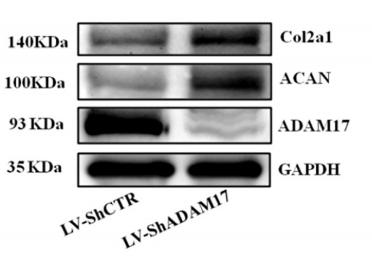ADAM 17 Antibody - #AF6361
| Product: | ADAM 17 Antibody |
| Catalog: | AF6361 |
| Description: | Rabbit polyclonal antibody to ADAM 17 |
| Application: | WB IF/ICC |
| Cited expt.: | WB, IF/ICC |
| Reactivity: | Human, Mouse, Rat |
| Prediction: | Bovine, Horse, Sheep, Dog |
| Mol.Wt.: | 93 kDa; 93kD(Calculated). |
| Uniprot: | P78536 |
| RRID: | AB_2835372 |
Product Info
*The optimal dilutions should be determined by the end user. For optimal experimental results, antibody reuse is not recommended.
*Tips:
WB: For western blot detection of denatured protein samples. IHC: For immunohistochemical detection of paraffin sections (IHC-p) or frozen sections (IHC-f) of tissue samples. IF/ICC: For immunofluorescence detection of cell samples. ELISA(peptide): For ELISA detection of antigenic peptide.
Cite Format: Affinity Biosciences Cat# AF6361, RRID:AB_2835372.
Fold/Unfold
A disintegrin and metalloproteinase domain 17 (tumor necrosis factor, alpha, converting enzyme); A disintegrin and metalloproteinase domain 17; ADA17_HUMAN; ADAM 17; ADAM metallopeptidase domain 17; ADAM17; ADAM17 protein; CD 156b; CD156b; CD156b antigen; CSVP; Disintegrin and metalloproteinase domain-containing protein 17; MGC71942; NISBD; NISBD1; Snake venom like protease; Snake venom-like protease; TACE; TNF alpha convertase; TNF alpha converting enzyme; TNF-alpha convertase; TNF-alpha-converting enzyme; Tumor Necrosis Factor Alpha Converting Enzyme;
Immunogens
A synthesized peptide derived from human ADAM 17, corresponding to a region within C-terminal amino acids.
Ubiquitously expressed. Expressed at highest levels in adult heart, placenta, skeletal muscle, pancreas, spleen, thymus, prostate, testes, ovary and small intestine, and in fetal brain, lung, liver and kidney.
- P78536 ADA17_HUMAN:
- Protein BLAST With
- NCBI/
- ExPASy/
- Uniprot
MRQSLLFLTSVVPFVLAPRPPDDPGFGPHQRLEKLDSLLSDYDILSLSNIQQHSVRKRDLQTSTHVETLLTFSALKRHFKLYLTSSTERFSQNFKVVVVDGKNESEYTVKWQDFFTGHVVGEPDSRVLAHIRDDDVIIRINTDGAEYNIEPLWRFVNDTKDKRMLVYKSEDIKNVSRLQSPKVCGYLKVDNEELLPKGLVDREPPEELVHRVKRRADPDPMKNTCKLLVVADHRFYRYMGRGEESTTTNYLIELIDRVDDIYRNTSWDNAGFKGYGIQIEQIRILKSPQEVKPGEKHYNMAKSYPNEEKDAWDVKMLLEQFSFDIAEEASKVCLAHLFTYQDFDMGTLGLAYVGSPRANSHGGVCPKAYYSPVGKKNIYLNSGLTSTKNYGKTILTKEADLVTTHELGHNFGAEHDPDGLAECAPNEDQGGKYVMYPIAVSGDHENNKMFSNCSKQSIYKTIESKAQECFQERSNKVCGNSRVDEGEECDPGIMYLNNDTCCNSDCTLKEGVQCSDRNSPCCKNCQFETAQKKCQEAINATCKGVSYCTGNSSECPPPGNAEDDTVCLDLGKCKDGKCIPFCEREQQLESCACNETDNSCKVCCRDLSGRCVPYVDAEQKNLFLRKGKPCTVGFCDMNGKCEKRVQDVIERFWDFIDQLSINTFGKFLADNIVGSVLVFSLIFWIPFSILVHCVDKKLDKQYESLSLFHPSNVEMLSSMDSASVRIIKPFPAPQTPGRLQPAPVIPSAPAAPKLDHQRMDTIQEDPSTDSHMDEDGFEKDPFPNSSTAAKSFEDLTDHPVTRSEKAASFKLQRQNRVDSKETEC
Predictions
Score>80(red) has high confidence and is suggested to be used for WB detection. *The prediction model is mainly based on the alignment of immunogen sequences, the results are for reference only, not as the basis of quality assurance.
High(score>80) Medium(80>score>50) Low(score<50) No confidence
Research Backgrounds
Cleaves the membrane-bound precursor of TNF-alpha to its mature soluble form. Responsible for the proteolytical release of soluble JAM3 from endothelial cells surface. Responsible for the proteolytic release of several other cell-surface proteins, including p75 TNF-receptor, interleukin 1 receptor type II, p55 TNF-receptor, transforming growth factor-alpha, L-selectin, growth hormone receptor, MUC1 and the amyloid precursor protein. Acts as an activator of Notch pathway by mediating cleavage of Notch, generating the membrane-associated intermediate fragment called Notch extracellular truncation (NEXT). Plays a role in the proteolytic processing of ACE2. Plays a role in hemostasis through shedding of GP1BA, the platelet glycoprotein Ib alpha chain (By similarity). Mediates the proteolytic cleavage of LAG3, leading to release the secreted form of LAG3 (By similarity).
The precursor is cleaved by a furin endopeptidase.
Phosphorylated. Stimulation by growth factor or phorbol 12-myristate 13-acetate induces phosphorylation of Ser-819 but decreases phosphorylation of Ser-791. Phosphorylation at THR-735 by MAPK14 is required for ADAM17-mediated ectodomain shedding.
Membrane>Single-pass type I membrane protein.
Ubiquitously expressed. Expressed at highest levels in adult heart, placenta, skeletal muscle, pancreas, spleen, thymus, prostate, testes, ovary and small intestine, and in fetal brain, lung, liver and kidney.
Must be membrane anchored to cleave the different substrates. The cytoplasmic domain is not required for the this activity. Only the catalytic domain is essential to shed TNF and p75 TNFR (By similarity).
The conserved cysteine present in the cysteine-switch motif binds the catalytic zinc ion, thus inhibiting the enzyme. The dissociation of the cysteine from the zinc ion upon the activation-peptide release activates the enzyme.
Research Fields
· Environmental Information Processing > Signal transduction > Notch signaling pathway. (View pathway)
· Human Diseases > Neurodegenerative diseases > Alzheimer's disease.
· Human Diseases > Infectious diseases: Bacterial > Epithelial cell signaling in Helicobacter pylori infection.
References
Application: WB Species: human Sample: NP cells
Application: WB Species: Mouse Sample: lung tissue
Application: IF/ICC Species: Mouse Sample: lung tissue
Restrictive clause
Affinity Biosciences tests all products strictly. Citations are provided as a resource for additional applications that have not been validated by Affinity Biosciences. Please choose the appropriate format for each application and consult Materials and Methods sections for additional details about the use of any product in these publications.
For Research Use Only.
Not for use in diagnostic or therapeutic procedures. Not for resale. Not for distribution without written consent. Affinity Biosciences will not be held responsible for patent infringement or other violations that may occur with the use of our products. Affinity Biosciences, Affinity Biosciences Logo and all other trademarks are the property of Affinity Biosciences LTD.





